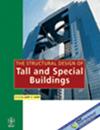Hydrodynamic characteristics and application of tuned liquid dampers with internal damping devices
IF 1.3
3区 工程技术
Q3 CONSTRUCTION & BUILDING TECHNOLOGY
引用次数: 1
Abstract
The hydrodynamic characteristics of rectangular tanks with internal damping devices, including baffles and paddles, are investigated using shaking table tests excited by colored noise. The complex second‐order blind identification method is employed to decouple fluid sloshing responses and to obtain mode shapes. The modal frequency and damping ratio are also identified by the modified Bayesian spectral density approach. The influence of baffle angle, paddle width, liquid depth, and excitation amplitude on the natural frequency and damping ratio of tuned liquid dampers (TLDs) is analyzed. Results show that the natural frequency is reduced due to the added mass produced by the damping devices, and the reduction increases gradually with the increase in the size of the damping devices, indicating that the influence of the added mass should be considered in the design. This result is essentially different from the conclusion of the existing finding that the modal frequency of TLD increases continuously with the increase in the baffle angle. Therefore, the tuning of TLD cannot be realized by rotating the baffles. Moreover, the damping ratio of TLD with paddles shows a nonlinear relationship with the fluid response. The nonlinear empirical model fitted by the test results can predict the damping ratio with high accuracy and can be used in the preliminary design of TLD for the wind‐induced vibration control of super‐tall buildings.带内阻尼装置的调谐液体阻尼器的水动力特性及应用
采用彩色噪声激励下的振动台试验,研究了带有内阻尼装置(包括挡板和桨叶)的矩形储罐的流体动力学特性。采用复杂的二阶盲辨识方法来解耦流体晃动响应并获得振型。模态频率和阻尼比也通过改进的贝叶斯谱密度方法识别。分析了挡板角度、桨叶宽度、液体深度和激励幅度对调谐液体阻尼器固有频率和阻尼比的影响。结果表明,由于阻尼装置产生的附加质量,固有频率降低,并且随着阻尼装置尺寸的增加,固有频率的降低逐渐增加,表明在设计时应考虑附加质量的影响。这一结果与现有发现的结论有本质的不同,即TLD的模态频率随着挡板角度的增加而连续增加。因此,TLD的调谐不能通过旋转挡板来实现。此外,带桨叶的TLD的阻尼比与流体响应呈非线性关系。试验结果拟合的非线性经验模型可以高精度地预测阻尼比,可用于超高层建筑风振控制TLD的初步设计。
本文章由计算机程序翻译,如有差异,请以英文原文为准。
求助全文
约1分钟内获得全文
求助全文
来源期刊
CiteScore
5.30
自引率
4.20%
发文量
83
审稿时长
6-12 weeks
期刊介绍:
The Structural Design of Tall and Special Buildings provides structural engineers and contractors with a detailed written presentation of innovative structural engineering and construction practices for tall and special buildings. It also presents applied research on new materials or analysis methods that can directly benefit structural engineers involved in the design of tall and special buildings. The editor''s policy is to maintain a reasonable balance between papers from design engineers and from research workers so that the Journal will be useful to both groups. The problems in this field and their solutions are international in character and require a knowledge of several traditional disciplines and the Journal will reflect this.
The main subject of the Journal is the structural design and construction of tall and special buildings. The basic definition of a tall building, in the context of the Journal audience, is a structure that is equal to or greater than 50 meters (165 feet) in height, or 14 stories or greater. A special building is one with unique architectural or structural characteristics.
However, manuscripts dealing with chimneys, water towers, silos, cooling towers, and pools will generally not be considered for review. The journal will present papers on new innovative structural systems, materials and methods of analysis.

 求助内容:
求助内容: 应助结果提醒方式:
应助结果提醒方式:


